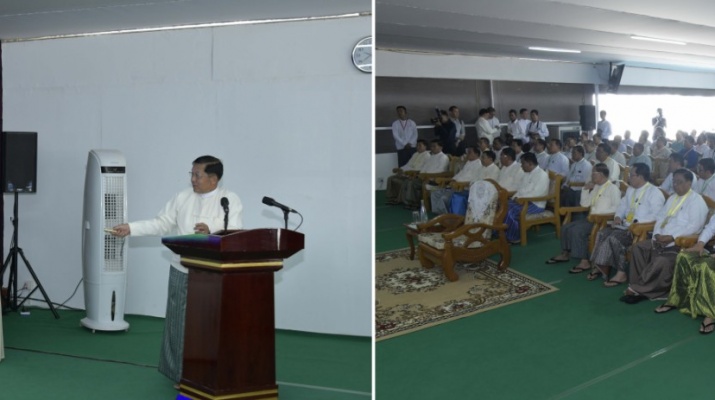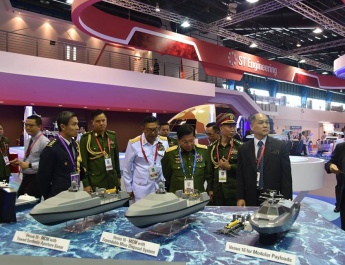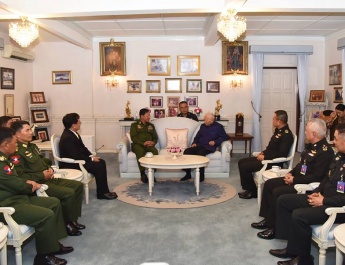NAY PYI TAW June 29
A ceremony to explain the progress in erecting the Maravijaya Buddha Image, which will become the tallest stone Buddha Statue in the seated posture in the world, in Maravijaya Buddha Park, Dekkhinathiri Township, Nay Pyi Taw, Union Territory, was held this morning.
Present were the main donor Chairman of State Administration Council Prime Minister Senior General Min Aung Hlaing, Chief of General Staff (Army, Navy and Air) General Maung Maung Aye, union ministers, union level officials, senior military officers from the Office of the Commander-in-Chief, the Nay Pyi Taw Command commander, Sasananuggaha Title holders, officials of local banks and companies, officials of Union of Myanmar Federation of Chambers of Commerce and Industry, officials of local TV channels and communication operators, officials of metal enterprises.
In explaining the Maravijaya Buddha Image project, which is being implemented for public obeisance, the Senior General said the ceremony is to explain the progress in building the Maravijaya Buddha Image that will become the tallest marble Buddha Statue in the world. All the attendees are the persons who are playing their respective roles in the development of the religious sector and socio-economic growth of the nation. Hence, the information about the progress in erecting the Image, the pride of the country, in Nay Pyi Taw is shared for the delightfulness.
The erection of Maravijaya Buddha Image has four objectives –to show the world that Theravada Buddhism is flourishing well in Myanmar, for the country, Myanmar, to become the centre of Theravada Buddhism, for national peace and prosperity and for global peace and tranquility. Myanmar is a true Theravada Buddhist country.
The country organized the Fifth Buddhist Synod during the reign of King Mind on and the Sixth Synod under the administration of Prime Minister U Nu. The Image is being built as a proof of the strong Theravada Buddhist foundation of the country. For the country to become the center of Theravada Buddhism,propagation programs are being prioritized. National prosperity ensures a booming economy, a peaceful public life and peaceful pursuit of education.
Buddhism is a religion that embraces peace, tranquility and loving kindness, and its goal is a peaceful and pleasant life that is under the protection of Dhamma. So, the Image is being erected with the aim of assuring global peace and prosperity.
In the late 2017, Former Head of State Senior General Than Shwe transferred a huge marble boulder donated to him for religious purpose to the Tatmadaw to lead the task of turning it into a Buddha image. After completion of a thorough check and calculation by mining experts, excavation work began in October 2018, and in March 2019, the 65 feet high, 154 feet long and 20 feet thick ‘A’ level boulder could be shaped into a rough figure of the image. More marble was added as some of the parts were not perfect.
The Image is being curved in accord with the Yadanabon period Bumiphassa posture, which was found to be the best design of the past successive periods. The country lost independence in 1885, and fell into an age of darkness beginning from 1 January 1886. The country regained independence only in 1948. The nation lost its culture under colonialism. Hence, Yadanabon design was chosen as the last relic of its civilization.
In accord with the tradition, the curving of the Image was based on its height. So, extra boulders of marble were sought for the throne and the knee of the Image. As road transport might have difficulties, the boulders were carried from Sakyin Hill to Hsimigon jetty along the Ayeyawady River.
After a careful inspection process, guidance was sought from Ovadacarira Sayadaws, and the huge boulders were carried by road in parts. Because of the enormous size of the boulders, difficulties were encountered during the journey. Tatmadaw engineering unit and Navy jointly built a canal from the Sakyin Hill to Myaing River to convey the boulders from the hill. They had to dig 92,507 pits in building the 4,583-foot long canal. Moreover, Hsimigon jetty was also extended for larger vessels.
Marble rocks were conveyed starting from 3 July 2020. These were systematically conveyed without any damage nine times, and these were weighing 8,158 tons. It was set on record of the world in conveyance of the stones in shipping. All marble rocks arrived at Hsimigon jetty on 18 September. A 22 miles and five furlong lone road was constructed to smoothly convey the rocks from Hsimigon jetty to Saka-in roundabout.
Then, these were conveyed to Nay Pyi Taw on 25 January 2021. In this regard, detours were built and roads were upgraded to convey the stones weighing between 1,500 tons to 2,000 tons. It took four months for construction. As marble rocks were started conveyance, COVID-19 broke out as well as political crises happened in the country. So, some people did not know detailed information about conveyance of the stones.
These rocks were conveyed on land seven times, and these weighs 7,632 tons. In this regard, Goldhofer Company of Germany which manufactured Modula Trailars to convey the stones presented certificates for longest route of conveyance in the largest weight of objects across the world. The heaviest stones were conveyed by shipping and through the longest land route.
In building the Buddha image, efforts were made for magnificence of the image. The land plot for the image was systematically calculated with the seeking advice from members of the State Sangha Maha Nayaka Committee. Efforts were made to build pagoda, monastery, lake and public-rest houses. In accord with the guidance of the Sayadaws, Tri Pita kat treatises were carved on the stone plaques in Pail and Romanize language in the Maravijaya Buddha Park. The title of the image was named Maravijaya in accord with the advice of Ovadacariya Sayadaws.
Systematic process was undertaken to express Tri Pita kat treatises in Pali and Romanize languages and print the treatises.
These treatises were published in high quality paper. Similarly, efforts are being made to insert application of treatises to the tablets. These treatises will be donated to religious centers of Buddhism across the world.
Steps were placed for construction of the image and park. The creek in the park was straightened and a bridge like Mingala Bridge of Mandalay Yadanabon era. Bored piles were built for construction of 20,000 tons capacity of structure for the Buddha image. Parts of thrones were conveyed and connected one another systematically.
Parts of the throne were carved with the use of CNC machines. Moreover, water fountains were systematically built in the park. Thudhamma public rest houses were built with the use of teak posts showing the Myanmar architectural works for public relaxation.
The Buddha image is carved with a nine feet high sample image under the advice of Sayadaws. The parts of the image were carved with the use of CNC machines.
Maravijaya Monastery was built in accord with the advice of Ovadacariya Saydaws for maintaining the Buddha image.
Such monastery can accommodate five members of the Sangha.
Likewise, Mucalinda Lake and Nagayon Pagoda were also built in line with the guidance of Ovadacariya Sayadaws and Buddhist treatises. In addition, three Kyee trees were also planted there.
Connection of the parts of Buddha images were difficultly carried out. Moving the parts of Buddha image were undertaken without mistakes. Stone plaque Cutis were built for public observance while visiting the Buddha image. So, Tri Pita kat treatises were carved on the stone plaques in Pail and Romanize languages with the use of modern machines.
These Cutis are similar to the stone plaque chambers from Maha Kuthodaw Pagoda in Mandalay. Rectors from Yangon, Mandalay and Sitagu Sasana Universities led the Sayadaws in editing the treatises in carving the stone plaques not to cause mistakes. Land plot for the stone plaque Cutis was systematically carried out. Moreover, 1,000 Bawdi banyan trees donated by nuns from Shwesinmin nunnery post-primary school and youth development home of PyinOoLwin were also planted around the Cutis.
Modern technologies were applied in connecting parts of the Maravijaya Buddha image.
These parts of the image were lifted up by Myanmar Engineering Society and Military Engineers’ Corps without any foreign experts. Part 1, 2 and 3 of the Image weighing 1,700 tons were lifted up with the use of steel basket which weighs 1,500 tons and steel tower, 250 tons. In this regard, efforts were made difficultly without any mistakes.
The ceremonies to enshrine religious objects in the reliquaries were held on January 27 and February 10 along with the precious gems donated by various donors across the country.
To be able to hold religious events grandly, Sasana Beikman Aggadhipati Visumgama Ordination Hall was built. The Sasana Beikman, 296 foot in length, 213 foot in width and 94 foot in height, is capable of having 900 Sanghas and 1,200 people. It is a consecrated ordination hall.
The advice on finishing works and offering the painting robe to the Maravijaya Buddha Image was received from Sayadaws.
It has been three years and 15 days long since the jewelled stake was driven for construction of the Buddha Image. For long-term endurance and existence of the Buddha Image, systematic measurements from the engineering point of view were made to lay a foundation capable of holding 20,000 tons in weight, to bear a storm with the 120 mph wind speed and an earthquake with 8.8 on the Richter scale as well as to protect the Buddha Image from thunderstorms. The combination of conventional and modern methods was used in joining stones of the Buddha Image together.
Lawns were included in building the platform of the Buddha Image. Special chambers were built with alabaster like the design of Atumashi Monastery in Mandalay in order that pilgrims were able to pay homage to the Buddha Image in hot weather. An escalator was installed there to enable the disabled and old people to get to the platform. A Bo tree from India was planted in the precinct of the Buddha Image and Sandbox and Sal trees will be planted in the precinct too. The Sal trees were donated by India. Progress of building a water fountain square and stone temple and the state of the Buddha Image and Buddha Park upon completion were explained with the help of video clips. He also said that as those who were at the ceremony are getting involved in making efforts for nationality and religion as well as for improvement of socio-economic life of the State such a briefing was made in detail with the aim that they will gain merit through knowing about building the Buddha Image.
Then, the Senior General received donations in cash from the attendees for building the Buddha Image and Buddha Park.
Afterwards, the Senior General thanked the donors saying a large sum of money was spent to build the Buddha Image and it is not easy to build such a Buddha Image again. Difficulties were experienced when building the Buddha Image.
Efforts were relentlessly made day and night to timely complete the Sasana Beikman. Religious title holders, bankers and economic persons were invited to let them know of the efforts to build the Buddha Image. This ceremony is being held amid the restrictions on the time and place.
It is learnt that donations were made generously. Names of those who made donations for buildings will be inscribed on stone slabs.
Then, the attendees took a tour of the Buddha Image and Buddha Park and they were briefed on the Buddha Image and Buddha Park by the Senior General and officials.
At the ceremony held today, 101 attendees donated Ks-16,177 million (Ks-16.177 billion) in total.




